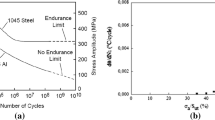Abstract
An environmental fatigue interaction (EFI) correlation is developed to predict the effects of hold periods on fatigue life at elevated temperatures for 2 1/4Cr-1Mo alloy steel tested in air. The physical basis for the model encompasses effects resulting from changes in interaction solid solution hardening (ISSH) and those effects induced by the oxidizing environment. The predictions from the correlation compare very favorably with all available experimental data. It is shown that other methods commonly used to predict the effects of hold time on fatigue life are based on damage mechanisms which are not appropriate to this alloy, and thus should not be used to extrapolate the shortterm laboratory data to service conditions. The information necessary to continue the development of this EFI correlation is discussed.
Similar content being viewed by others
Abbreviations
- ∈:
-
strain rate
- Δ∈T :
-
total strain range
- Δ∈p :
-
plastic strain range
- T:
-
temperature
- t:
-
time
- tc :
-
time for one fatigue cycle
- tT :
-
time for the tension half of one fatigue cycle
- Nf :
-
number of cycles to failure
- Nn :
-
number of cycles to crack initiation
- Np :
-
number of cycles for crack propagation
- m:
-
metal loss in oxidation
- h:
-
oxide thickness
- ρ:
-
density
- ∈ 0 f :
-
tensile strain to fracture the oxide
- γ1 :
-
constant proportional to the surface energy density required to form a crack in the oxide
- E:
-
Young’s Modulus
- N EFI f :
-
cycles to failure predicted by the EFI correlation
- ∈ 0 T :
-
tensile strain in the oxide
References
L. K. Severud: “Elevated Temperature Fatigue-Design Application Perspective with Directions for Improvements,”7976 ASME-MPC Symposium on Creep-Fatigue Interaction, R. M. Curran, ed., MPC-3, New York, 1976, pp. 4156.
K. D. Challenger, A. K. Miller, and C. R. Brinkman:J. Eng. Mater. Tech., vol. 103, pp. 7–14.
Nuclear Systems Materials Handbook, Part 1, Group 2, Section 2, Property Code 4102, “Air Side Corrosion,” Revision 6-27-74.
R. L. Langdon: “Calculation of the Oxide Growth Rate of 2 1/4Cr-lMo Steel in Air and the Subsequent Measurement of the Strain Required to Crack the Oxide,” MS Thesis, Naval Postgraduate School, Monterey, CA, September 1980.
J. Armitt, R. Holmes, M. 1. Manning, D. B. Meadowcroft, and G. Metcalfe: “The Spalling of Steam Grown Oxides from Superheater and Reheater Tube Steels,” Electric Power Research Institute Report Number EPRI FP-686 TPS 76-655, February 1978.
M. Gell and G. R. Leverant:Fatigue at Elevated Temperatures, A. E. Carden, A. J. McEvily, and C. H. Wells, eds., ASTM, STP 520, 1972, pp. 37–68.
Mechanical Properties Test Data for Structural Materials, Progress Report for the Period Ending April 30, 1975, Oak Ridge National Laboratory, ORNL-5I05, June 1975, pp. 8–10.
R. S. Prevey and W. P. Hosier: “Effect of Surface Integrity on Fatigue of Structural Alloys at Elevated Temperatures,” op. cit. 4, pp. 522–34.
J. C. Grosskreutz and D. K. Benson:Surfaces and Interfaces II; Physical and Mechanical Properties, J. J. Burke, N. L. Reed, and V. Weiss, eds., Syracuse Univ. Press, Syracuse, NY, 1968, pp. 61–94.
J. B. Conway, R. H. Stentz, and J. T. Berling:Fatigue, Tensile and Relaxation Behavior of Stainless Steel, U.S. A.E.C. Report T1D-26135, 1975.
K. D. Challenger and J. Moteff:Metall. Trans., 1972, vol. 3, pp. 1675–78.
K. D. Challenger and J. Moteff: “Correlation of Substructure with the Elevated Temperature Low-Cycle Fatigue of A1SI 304 and 316 Stainless Steels,” op. cit. 4, pp. 69–79.
L. F. Coffin, Jr.:Trans. Metall. Soc. AIME, 1974, vol. 230, pp. 1690–99.
D. R. Diercks and D. T. Raske: “Elevated Temperature, Strain-Controlled Fatigue Data on Type 304 Stainless Steel: A Compilation, Multiple Linear Regression Model and Statistical Analysis,” Argonne National Laboratory, ANL-76-95, December 1976.
C. R. Brinkman, J. Strizak, and M. K. Booker: “Use of Strain-Range Partitioning for Predicting Time-Dependent, Strain Controlled Cyclic Lifetimes of Uniaxial Specimens of 2 1/4Cr-lMo Steel, Type 316 Stainless Steel, and Hastelloy X,” Oak Ridge National Laboratory, ORNL-5396, June 1978.
S. S. Manson, G. R. Halford, and M. H. Hirschberg: “Creep-Fatigue Analysis by Strain-Range Partitioning,” NASA Technical Memorandum, NASA TMX-67838, 1971.
R. D. Campbell:J. Eng. Ind., 1971, vol. 93, pp. 887–96.
Interpretations of the ASME Boiler and Pressure Vessel Code; Case 1592, ASME, New York, 1974.
M. K. Booker: “Construction of Creep-Fatigue Elastic-Analysis Curves and Interim Analysis of Long-Term Creep-Fatigue Data for 2 1/4Cr-lMo Steel,” Oak Ridge National Laboratory, ORNL TM-6324, July 1978.
S. Taira:Creep in Structures, N. J. Huff, ed., Springer Verlag, Berlin, 1962, pp. 96–119.
E. L. Robinson:Trans. ASME, 1938, vol. 60, pp. 253–59.
Author information
Authors and Affiliations
Rights and permissions
About this article
Cite this article
Challenger, K.D., Miller, A.K. & Langdon, R.L. Elevated temperature fatigue with hold time in a low alloy steel: A predictive correlation. JMES 3, 51–61 (1981). https://doi.org/10.1007/BF02833529
Issue Date:
DOI: https://doi.org/10.1007/BF02833529




